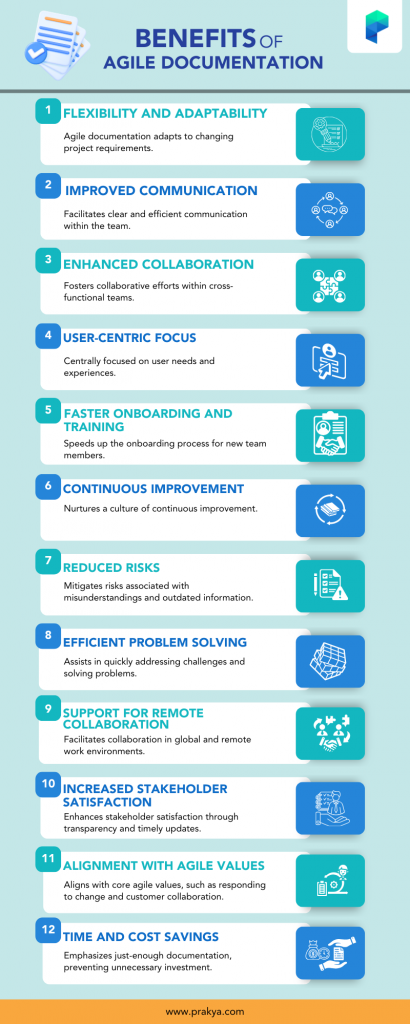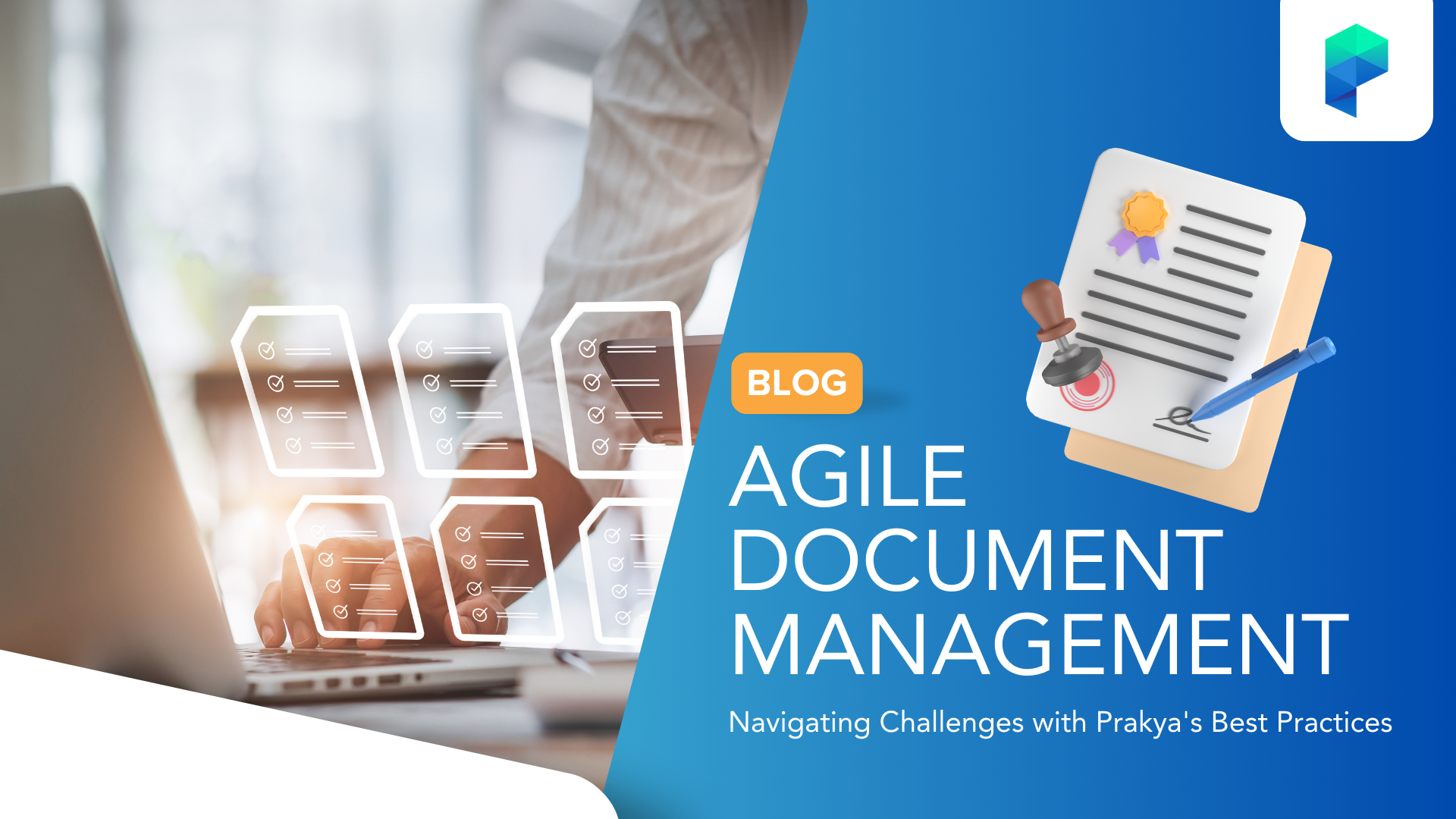“Provide only what’s necessary and weed out the excess. “
When it comes to tools and technologies, we’re not just looking for solutions; we’re looking for streamlined, no-nonsense options that get the job done without overwhelming us. We’re constantly redefining our approach to work, collaboration, communication and much more. And one such approach we all know and are willing to turn to is Agile methodology.
In the quest for efficient management and providing just enough information, Agile teams understand that providing the right information at the right time without unnecessary clutter is key. This principle extends to agile document management.
It’s a well-known fact that traditional document management software followed a comprehensive approach while on the contrary agile chose to provide working software over comprehensive documentation. Yet, agile teams face certain hurdles as they strive for efficiency and collaboration. They encounter a unique set of challenges that demand innovative solutions.
Agile teams often grapple with striking the right balance between keeping records of their work and swiftly delivering functional software. Imagine a group working on a project where requirements change frequently. This can be like trying to hit a moving target, making it tricky to keep documents up to date.
With tight schedules in short development cycles, there’s a constant struggle to find time for both coding and thorough documentation. Team members might resist documentation, viewing it as unnecessary paperwork, resulting in incomplete or hastily done records. Without dedicated resources or clear responsibilities for documentation, it becomes an afterthought rather than a priority.
Additionally, using the right documentation tools and maintaining their relevance throughout the project can be stumbling blocks, akin to navigating through a maze. Effective communication is crucial, as misunderstandings among team members can lead to inconsistent or insufficient documentation.
As teams grow, so do the challenges, with coordinating documentation efforts across multiple teams and ensuring consistency becoming even more complex. To overcome these hurdles, agile teams need to embrace a collaborative culture, invest in user-friendly documentation tools, assign specific responsibilities for documentation tasks, and continuously refine their approach based on project needs.
Let us delve deeper and see what strategies agile approach adapts to pass these hurdles.
Challenges and Strategies to overcome in Agile Document Management
The Struggle of Minimal Viable Documentation (MVD)
Figuring out how much documentation is enough—what we call Minimal Viable Documentation (MVD)—can be tricky.
Minimal Viable Documentation (MVD) serves as a strategic approach, emphasizing the creation of essential documentation to support project development without compromising efficiency. Unlike traditional methods, MVD promotes a “Just-in-time” approach. It entails generating documentation as needed, focusing on key elements such as User Stories and Acceptance Criteria and Living Documentation to articulate project requirements succinctly.
There is no one-size-fits-all solution when it comes to the amount and type of documentation required for a project. The documentation needs can vary significantly based on the nature of the project, the size of the team, the industry, and the specific requirements of stakeholders.
For instance, a large-scale software development project may require more comprehensive documentation to ensure effective communication and coordination among a larger team, while a smaller, more agile team working on a prototype may find that a lighter documentation approach is more suitable. Similarly, regulatory compliance requirements in certain industries may necessitate more extensive documentation compared to projects in less regulated domains.
Team dynamics, the level of technical complexity, and the preferences of stakeholders also play crucial roles in determining the appropriate level of documentation. Some teams may prioritize visual aids such as diagrams and charts and interactive documentation, while others may lean towards more textual and detailed documentation.
In essence, the adaptability of MVD recognizes that the optimal amount of documentation is contextual and should be tailored to the unique characteristics and needs of each specific team and project. This adaptability allows teams to find the right balance that supports efficient project development without unnecessary bureaucratic overhead.
Collaboration and Communication vs. Documentation
Agile places a significant emphasis on teamwork, valuing face-to-face interactions, collaboration, and rapid response to change. On the other hand, the need for documentation is undeniable, as it serves as a crucial reference point, aids in knowledge transfer, and provides clarity on project goals and requirements.
Insufficient documentation can lead to misunderstandings, knowledge gaps, and difficulties in onboarding new team members. Striking the right equilibrium requires careful consideration of the team’s communication patterns, the nature of the project, and the specific needs of stakeholders.
To pass this hurdle, Agile practices such as Daily Stand-ups and sprint reviews attempt to address this complexity by promoting real-time communication and collaboration, where decisions are made swiftly, and challenges are addressed promptly. Thus, reducing the reliance on extensive documentation.
Evolution of Project Requirements
In Agile, change is expected, and so are changes in project requirements. As projects evolve, the documentation strategy needs to be kept up. How can teams document changes efficiently without slowing down the progress? This challenge emphasizes the need for living documentation—documents that can adapt and respond to the shifts and changes in Agile projects.
Living documentation is a dynamic and continually updated resource, that ensures alignment with the evolving project landscape.
Living document not only captures the current state but also offers a historical context, enabling teams to review past decisions and understand the evolution of the project. It serves as a valuable tool to align teams, especially those not directly involved in oral communication processes, by providing insights into why certain decisions were made at specific points in time.
Living documentation thus bridges the gap between past and present contexts, fostering better understanding and alignment across the team.
Leveraging Visual Aids
Agile teams leverage visualization tools as powerful allies in their document management strategy. Visualization boards, Kanban boards, and dynamic tools replace static documents. These visual aids offer a real-time snapshot of project progress, making information easily accessible. The result is a transparent and efficient approach to managing project information.

Best Practices of Prakya in Agile Document Management for Seamless Workflow
Prakya emerges as a formidable ally in navigating the intricacies of Agile workflows, providing practical solutions to enhance collaboration, streamline workflows, and redefine how teams manage documents in Agile projects.
Contextual Documentation
In Prakya, documents integrate seamlessly with various Agile artifacts, including Epics, Features, and User Stories. This integration allows for comprehensive aggregation, providing the flexibility to access documentation – independently at the item level and collectively at the Epic level. Prakya ensures a contextual approach that aligns documentation precisely with the project’s hierarchical structure, enhancing clarity and accessibility.
AI-Driven Contextual Documentation
Prakya’s AI-based contextual documentation feature simplifies and streamlines the creation of documentation snippets such as simple descriptions, Acceptance Criteria and Definitions of Done for User Stories and Features. This not only aligns with Agile principles but also ensures that documentation is generated swiftly and within the project context.
AI-Driven Execution Support
Prakya’s AI is rigorously trained to extract action items from any document, such as meeting notes. This AI-driven execution support enhances the productivity, for instance – of Agile meetings, by automating the transcription and sharing of meeting notes.
Using a combination of training data, and reinforcement learning Prakya’s AI extracts ideas and action points and continuously keeps learning from user interactions. This feature ensures that Agile discussions seamlessly translate into actionable tasks.
Additionally, it helps create follow-through and feedback structures, ensuring that team discussions are not only documented but also followed through.
Customizable Workflows
Prakya’s customizable workflows empower Agile teams to organize work items, such as features and user stories, in a tailored Kanban board. This flexibility aligns with Agile principles, allowing teams to adapt to changing project requirements and ensuring an agile approach from the project’s inception.
Visually Manage Your Value Creation
Prakya’s visual orchestrator enables teams to visually represent their value stream activities, supporting detailed mapping of components and their interconnections. This feature aligns with Agile’s iterative nature, allowing teams to dynamically update and publish visual progress while effortlessly tracking version history.
Enhanced Solution Architecture
Prakya allows visual documentation of business processes and solution architecture, following an approval process and maintaining version history. This enables solution architecture teams to keep updating the architecture, making it a living document that aligns teams and brings visibility to the entire team.
Centralized Document Management
Prakya’s document store serves as a centralized platform, putting an end to the chaos of scattered files. This unified hub accelerates workflows, providing visibility and supporting Agile teams in their endeavors. It ensures that documentation is easily accessible, fostering collaboration and reducing the need to toggle between different sources.
Seamless Content Collaboration
Prakya ensures that context is never lost by facilitating seamless content collaboration within the platform. The document store becomes a singular repository, allowing teams to share documents without constant context-switching. This leap forward enhances clarity, promotes smooth collaboration, and aligns with Agile’s emphasis on communication and interaction.
Encouraging Open Teamwork
By enabling the sharing of the right information at the right time within the project context, Prakya fosters openness and builds trust among team members. The document store becomes a virtual meeting point, promoting transparency and shared responsibility. This aligns with Agile principles, emphasizing the importance of individuals and interactions.
Inspiring Meaningful Conversations
Prakya encourages teams to share information and engage in meaningful conversations that add value to the project. This not only develops team spirit but also builds trust, fostering a collaborative environment in line with Agile principles.
With Prakya you can save time spent collecting and collating documents from different sources like email threads and team chats.
Closing Thoughts
In wrapping up our exploration of Agile document management, it’s evident that Prakya is more than just a tool – it’s a game-changer for Agile teams. With Prakya, efficiency takes center stage as it effortlessly generates work items and adapts workflows, reshaping how we approach Agile processes. Collaboration thrives with Prakya’s centralized document management, making teamwork seamless and meetings more productive. The emphasis on living documentation and visual tools ensures that transparency isn’t just a goal but a daily reality. Prakya isn’t just about overcoming Agile challenges; it embodies the spirit of Agile evolution, turning obstacles into opportunities.
Prakya meets the dynamic needs of Agile teams while also embracing simplicity and adapting minimalism to document management, just as the world needs it now. It provides the right information at the right time. That is why Prakya’s team members refer to Prakya as a powerhouse that handles heavy lifting in the background, while making things easy for the team. It exists as an invisible team member, making the work easy for you and yielding visible results.





